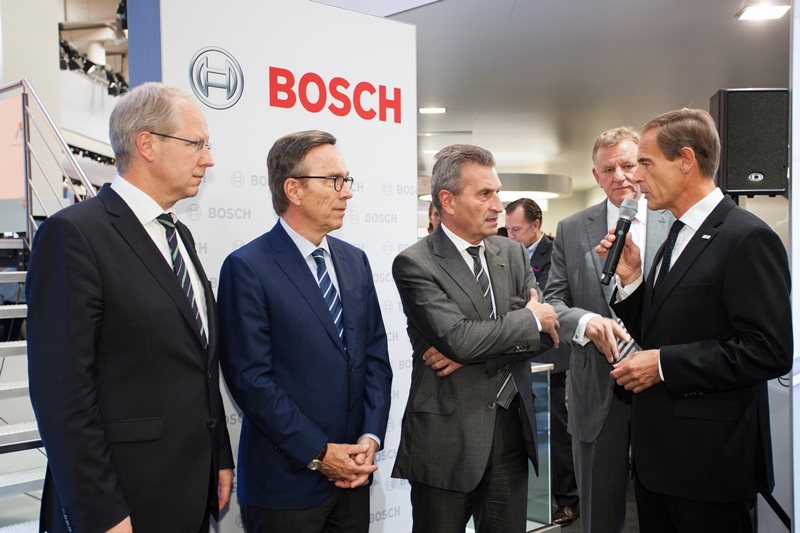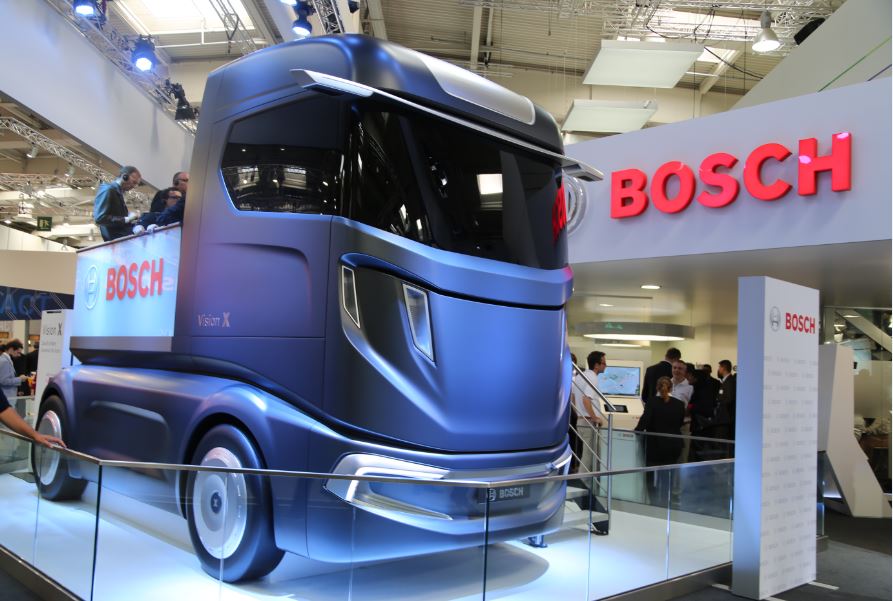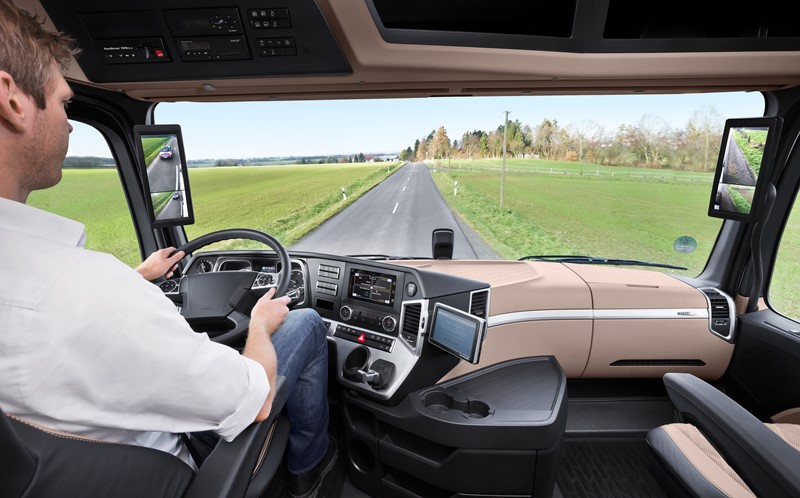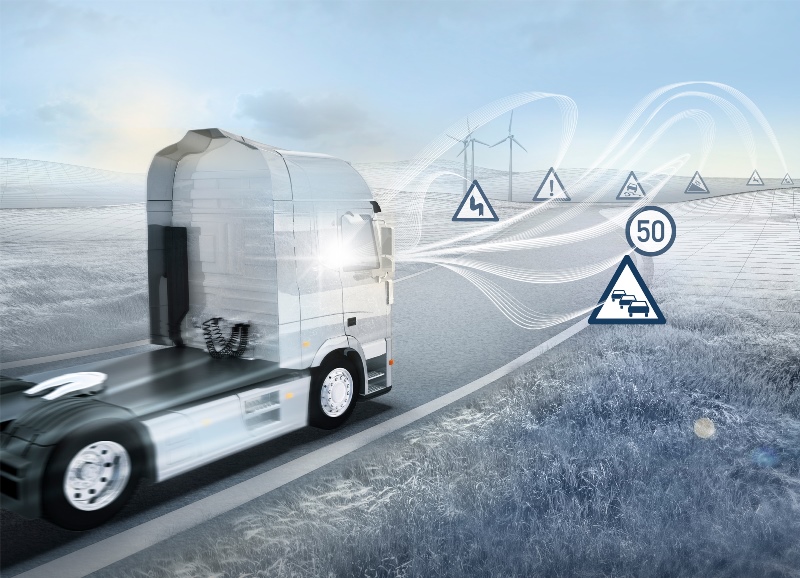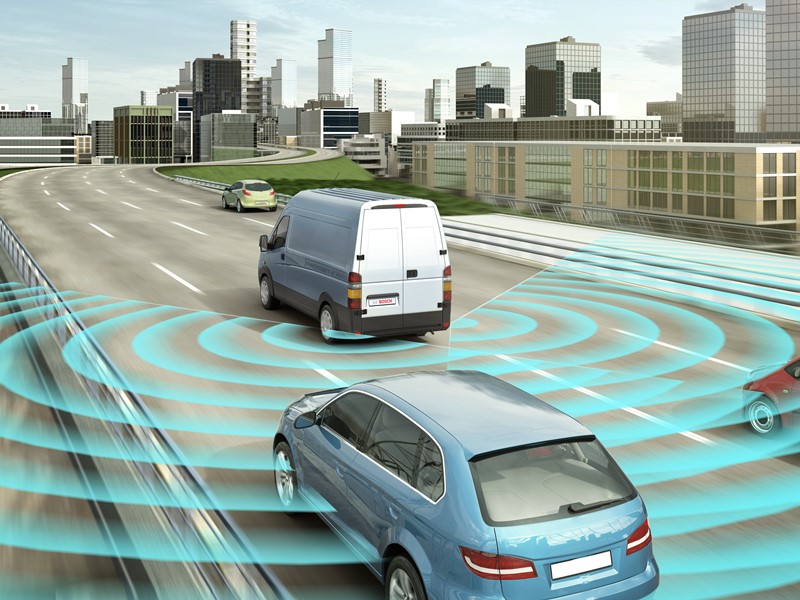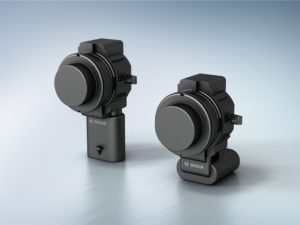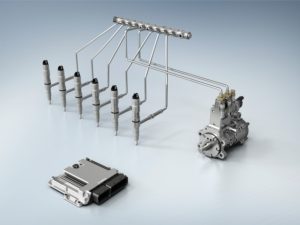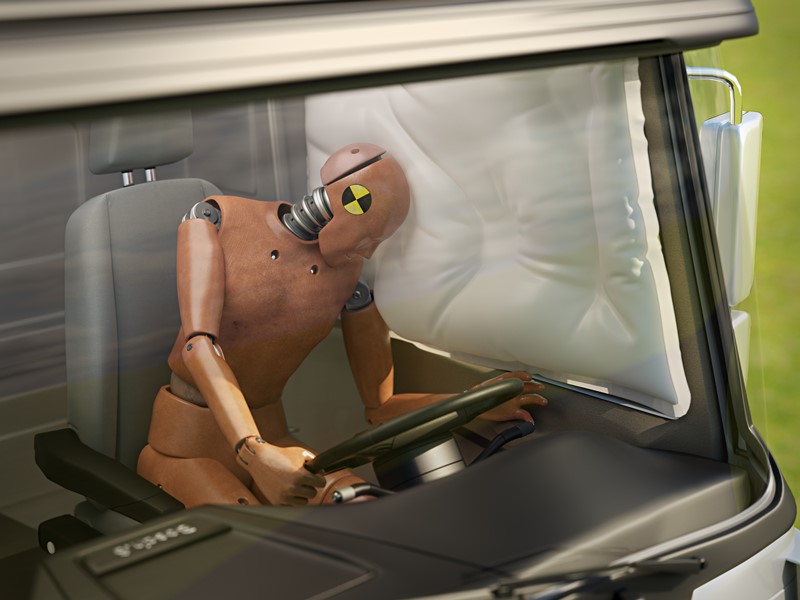Bosch is turning the truck into a technology showpiece. At the 66th International Motor Show for commercial vehicles in Hannover, the supplier of technology and services is presenting its ideas and solutions for the connected, automated, and electrified commercial vehicles of tomorrow at booth B12 in hall 17.
Everything in view with digital side-view mirrors and modern displays
New display and user interfaces: Connectivity and infotainment functions are becoming ever more comprehensive. Bosch is putting large displays and touchscreens in trucks to make these functions easy to use. Freely programmable displays show the information relevant at any particular time. For example, in dangerous situations, the displays give priority to warnings and highlight them visually. Bosch’s innovative neoSense touchscreen gives users haptic feedback as they operate the display. The buttons on the touchscreen feel like real buttons, so drivers can often operate them without looking. Simple operation, intuitive menu navigation, and hence less distraction are benefits to be had from all the kinds of smartphone integration that Bosch offers, too. Besides Apple CarPlay, Bosch mySPIN is the only other solution that can connect Android and iOS devices to the infotainment system. Bosch is also working on GPS devices that will make maps just as accessible. It takes 3D elements such as conspicuous buildings and displays it on an additional level of the map to help users find its bearings. Real-time information about the weather or gas prices can also be included.
Digital exterior mirror: On commercial vehicles, large mirrors left and right ensure that drivers can see behind them. But although these mirrors are vital for safety, they interfere with the vehicle’s aerodynamics and the driver’s forward view. At the IAA, Bosch presents its camera-based solution that completely replaces the two side-view mirrors. Called the Mirror Cam System, it reduces wind resistance considerably and therefore cuts fuel consumption by 1 to 2 percent. The video sensors can be integrated into the driver’s cab, which is also where the monitors that display the video images are located. This digital technology makes it possible to have a situation-specific display. So when the truck is driving on the highway, the driver can see further behind the vehicle, while in cities the angle of view is made as large as possible to provide greater safety. Enhanced contrast improves visibility during night driving.
More safety and efficiency on the road with Bosch connectivity solutions
Connectivity control unit: Bosch’s connectivity control unit (CCU) is a central connectivity solution for commercial vehicles. The CCU communicates via a wireless module equipped with its own SIM card and can determine the vehicle’s position using GPS if desired. It is available both as original equipment and as a retrofit solution; for example, it can be connected to the vehicle’s electrical system via the on-board diagnosis (OBD) interface. The CCU sends vehicle operating data to a cloud server, unlocking a variety of potential services. For many years now, Bosch has also produced a trailer control unit, a connectivity solution for trailers. The unit can document the trailer’s position, refrigeration temperature, or severe vibrations and report these immediately to the fleet operator.
Connected horizon: Bosch’s electronic horizon has been available for several years, and the company is now expanding it to include real-time data. Besides topographical information, the assistance function will also be able to draw on real-time data from the cloud. This will allow the engine and transmission management to take construction areas, traffic jams, or even icy patches into account. Automatically adjusting the vehicle’s speed in advance can further reduce fuel consumption, thereby increasing efficiency.
Secure truck parking: The app-based solution facilitates the online reservation of secure truck parking spaces at rest areas along the freeway plus cashless payment. For this to work, Bosch connects the parking lot infrastructure with the information and communication systems used by dispatchers and truck drivers. Bosch provides real-time information on available parking spaces from its own cloud. The parking areas are secured by means of intelligent video technology, while entry to the area is controlled using license plate recognition.
Entertainment for tour buses: Powerful Bosch infotainment systems offer tour bus drivers a wide range of interfaces for feeding various types of multimedia content into the system and then playing it back on high-resolution monitors and HD sound systems, also made by Bosch. Meanwhile, the Coach Media Router offers passengers custom entertainment. This Bosch system offers passengers both wi-fi and a streaming function for movies, TV series, music, and magazines. To save bandwidth, movies can be stored locally on the device.
Eyes and ears for assisted and automated driving MPC multi-purpose camera: The MPC 2.5 is a multi-purpose camera that was developed especially with the requirements of heavy commercial vehicles in mind. Its integrated image processing system identifies, classifies, and locates objects in the vehicle’s surroundings with a high degree of precision and reliability. Besides a predictive emergency braking system, which has been mandatory across the EU since fall 2015 for all trucks with a gross vehicle weight of more than eight metric tons, the camera opens up a host of assistance functions. One of these is intelligent headlight control, which automatically turns on the headlights during night driving or in tunnels. The camera also aids recognition of traffic signs, incorporating them into the cockpit display to keep the driver better informed. Similarly, the camera serves as a basis for various lane assistants: the lane-departure warning system alerts drivers that they are in danger of drifting out of their lane by, for example, vibrating the steering wheel. Thanks to intelligent, redundant lane recognition algorithms, the MPC 2.5 also serves as the basis of a lane-keeping system, which keeps the vehicle in its lane by making gentle steering interventions.
Front mid-range radar sensors: For light commercial vehicles, Bosch offers the front mid-range radar sensor (MRR front). This radar sensor detects objects in front of the vehicle and determines its speed as well as position relative to the vehicle. Furthermore, the sensor sends frequency-modulated radar waves measuring between 76 and 77 GHz via the transmitting antennae. With the MRR front, Bosch can implement driver assistance functions such as ACC adaptive cruise control and a predictive emergency braking system.
Rear mid-range radar sensor: The rear-mounted version of the mid-range radar sensor (MRR rear) enables drivers of light commercial vehicles to monitor its blind spots. Vehicles are equipped with two sensors, one hidden at each end of the rear bumper. This system detects any vehicles in the truck’s blind spot and warns the driver.
Stereo video camera: Bosch’s compact SVC stereo-video camera is a single sensor solution for many driver assistance systems in light commercial vehicles.
It registers the vehicle’s surroundings and empty spaces in front of the vehicle completely in three dimensions, providing a 3D view that extends for more than 50 meters. Each of the two highly sensitive image sensors, equipped with colour recognition and CMOS (complementary metal oxide semiconductor) technology, has a resolution of 1280 by 960 megapixels. The camera helps realize numerous safety and convenience functions. These range from automatic emergency braking to assistants for traffic jams, construction zones, tight spaces, and evasive steering, and all the way to ACC. The SVC also supports intelligent headlight control, a lane-departure warning system, a lane-keeping or lateral guidance assistant, and traffic-sign recognition.
Near-range camera systems: With its near-range camera systems, Bosch helps drivers of light commercial vehicles enjoy accident-free parking and maneuvering. Based on CMOS technology, the reversing camera helps drivers when reversing by providing them with a faithful representation of the immediate vicinity. Four near-range cameras together provide the basis for the Bosch multi-camera system. One camera is installed at the front, one at the rear, and one in each of the two side-view mirrors. With an aperture of 192 degrees each, it captures the vehicle’s entire surroundings. Thanks to special visualization technology, the display unit provides images in 3D. Drivers are also free to choose any perspective they wish, so they can see even small obstacles in the parking area.
Ultrasonic sensors: It is often very difficult to see around light commercial vehicles, but Bosch ultrasonic sensors can track a vehicle’s surroundings to a distance of up to four meters. In this way, they can spot possible obstacles and determine the constantly changing distance to these obstacles as the vehicle maneuvers. This sensor information feeds into the parking assistance systems that support the driver in accident-free parking and maneuvering.
Bosch steering systems for commercial vehicles are setting the course
Servotwin: Bosch Servotwin improves the efficiency and convenience of heavy commercial vehicles. The electro-hydraulic steering system offers speed-dependent steering support with active response and consumes less fuel than purely hydraulic steering. Servotwin reliably compensates for potholes and provides the driver with a good grip on the pavement. Thanks to its electronic interface, the steering system is simultaneously the basis for driver assistance functions such as a lane-keeping assistant or cross-wind compensation. The steering system has many fields of application, including in Mercedes-Benz’s self-driving Actros.
Rear-axle steering: eRAS, the electric Rear Axle Steering system, lets commercial vehicles with three or more axles use the leading and trailing axles to steer. This makes the turning radius smaller and reduces wear on the tires. eRAS has two components: the cylinder unit with an integrated route sensor and valve system, and the power unit. The latter consists of an electrically powered pump and a control unit. Based on the steering angle of the front axle, transmitted by CAN bus, the steering system determines the optimum steering angle for the rear axle. After driving around a bend, the system also assumes the task of straightening out the wheels. Only when the vehicle is actually being steered does eRAS consume energy.
Electronic control unit for airbag: With the electronic control unit for airbags, Bosch is improving protection for occupants in heavy commercial vehicles. The electronic control unit reads signals sent by the acceleration sensors to determine the force of the collision and promptly activates the passive security systems, such as seat-belt pretensioners and airbags. In parallel, the electronic control unit constantly analyzes vehicle movement and recognizes critical situations, such as when a truck rolls over. The information is used to trigger seat-belt pretensioners and side and front airbags, and mitigate the consequences of the accident for the vehicle occupants.
Electrifying the powertrain means more torque and less fuel consumption
48-volt entry-level hybrid: Boost recuperation system: The Bosch 48-volt entry level hybrid for light commercial vehicles enables fuel-saving coasting, while its higher power means it makes better use of energy recovery than applications based on conventional voltage levels. As a replacement for the conventional generator in belt drives, the 48-volt BRM boost recuperation machine achieves comfortable engine starts. The belt-driven starter-generator is easy to integrate into an existing powertrain. As a highly efficient generator, the BRM converts braking energy into electrical energy, which can then be used by other electrical power consumers or the boost function.
Electrical hybrid powertrain: Bosch has developed a parallel hybrid system with 120 kW of power for heavy commercial vehicles. The system makes it possible to cut fuel consumption by up to 6 percent. It can also be used in commercial vehicles weighing 26 to 40 metric tons as well as in off-highway applications. The main components for long-haul transport are the electric motor and power electronics. The space-saving electric drive is integrated into the powertrain between the engine and gearbox, so that no extra transmission is needed. It assists the internal-combustion engine, recuperates energy, enables coasting, and makes electric driving possible. The inverter transforms the direct current stored in the battery into alternating current for the motor, and controls the desired torque and engine speed. A start-stop function can also be integrated, opening up further fuel-saving potential, especially in urban delivery traffic.
Variable turbine geometry: Similar to what is happening in the passenger vehicle segment, requirements in the commercial vehicle segment regarding the reduction of fuel consumption and emissions are continuing to become ever stricter. There is a critical role for exhaust-gas turbocharging to play in response to this. Besides reducing friction and increasing the thermodynamic efficiency by means of optimized aerocomponents, Bosch Mahle Turbo Systems (BMTS) is developing a variable turbine geometry (VTG) for commercial vehicle engines. The focus of development here is primarily on achieving a high degree of thermodynamic efficiency throughout the entire geometry range and improving the robustness of the overall system.
Modular common-rail system: the right solution for any requirement
Versatile: The sophisticated common-rail system for commercial vehicles helps meet current and future requirements for on- and off-highway operation. Although the modular system is designed for engines of between four and eight cylinders, it can be used in the off-highway area even in engines of up to twelve cylinders. The Bosch system is suitable for 4 to 17 liters engine displacement and engine power of up to 635 kW in the on-highway segment and 850 kW in off-highway.
The right fit: System components and modules can be put together in different combinations to meet the engine manufacturer’s specific requirements. That includes fuel- and oil-lubricated pumps (CP4, CP4N, CP6N), injectors (CRIN) for various installation situations, as well as rails and electronic control units of the new MD1 generation optimized in a networked system. Flexible and scalable: Since various pressure levels between 1,800 and 2,500 bar are possible, manufacturers can fulfill the requirements of a wide range of segments and markets as far as possible. Depending on the demands it is subject to, the system can last for up to 1.6 million kilometers in on-highway operation, or 15,000 hours off-highway. Very high injector flow rates make it possible to optimize the combustion strategy and achieve high engine performance.
Efficient: The electronically regulated eGP fuel pump allows for demand-based fuel pre-supply, thereby reducing the necessary powertrain performance. With up to eight injections per cycle, improved injection patterns, and optimized injectors, it allows consumption to be improved still further.
Economical: All in all, the modular system helps cut fuel consumption by up to 1 percent compared to conventional systems. In a heavy-duty truck, this corresponds to savings of up to 450 liters of diesel per year. The system is also designed for the electrification of the powertrain; for example, it permits the 500,000 start/stop processes needed for hybrid operation.
Other Bosch innovations for internal-combustion engines in commercial vehicles
Baseline common-rail system for emerging markets: CRSN Baseline systems, with up to 2,000 bar system pressure for medium and heavy-duty vehicles as well as off-highway applications, are perfectly tailored for the requirements of emerging markets. Among other things, the system contains a broad product range of oil-lubricated pumps and baseline injectors. The high degree of efficiency in system integration, calibration, and validation makes it possible to quickly equip new vehicles with these systems.
Natural gas powertrain system: Commercial vehicles with a natural gas powertrain are the quiet, cost-effective, and low-emission alternative to diesel. Bosch technology in OE quality can help reduce CO2 emissions by up to 20 percent. Bosch is methodically refining the CNG powertrain. Its portfolio includes components for engine management, fuel injection, ignition, air management, exhaust gas treatment, and turbocharging.
Exhaust-gas treatment: Limits set by future emissions legislation will almost certainly be met only with the help of an active exhaust-gas treatment system, e.g. with an SCR catalytic converter to reduce nitrogen oxides. The Denoxtronic dosing system injects AdBlue, a solution of 32.5 percent urea in water, into the exhaust gas flow ahead of the SCR catalytic converter. In the SCR catalytic converter, the ammonia then breaks down the nitrogen oxides into water and nitrogen. By processing current engine operation data and all necessary sensor data, the system can match the quantity of the reducing agent precisely to the engine operating point and to the specific properties of the catalytic converter for maximum nitrogen oxide conversion.
